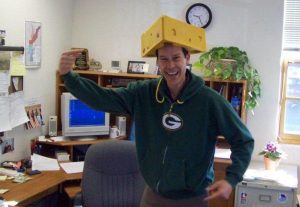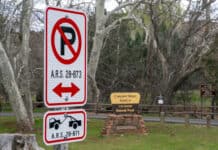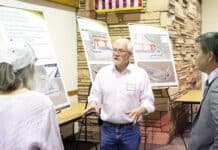Some visitors come to witness the glory of the red rocks, others come for the miles of serene hiking trails or to dip their toes in a tranquil spot along the Oak Creek. Yet many more make the pilgrimage from far and wide to see a McDonald’s unlike any other in the world.
Located in the Safeway shopping center off State Route 89A in West Sedona, the Pueblo-revival, pseudo-Santa Fe-style adobe building’s exterior features a ginger-colored base with embedded wrap-around reflective windows and doors. The top is a lighter sand color with a tiered roof that adds dimension.
But the real draw of the Sedona McDonald’s is its arches. Some say they’re teal, others say turquoise, but whatever the color, they are certainly a far cry from the traditional ketchup-and-mustard-colored logo the conglomerate sports at its other 37,854 locations worldwide.
“We wanted something more consistent with Sedona’s unique environment and character,” said John O’Brien, who worked for the city of Sedona as city planner when the anomalous franchise was built in 1993.
Not long after the Safeway shopping center was built in 1990, McDonald’s representatives reached out to the city to place one of its iconic restaurants in the plaza.
“When they came in they first wanted to do the typical McDonald’s building … and the city staff had design review guidelines in place so … the typical McDonald’s design didn’t really satisfy,” O’Brien said. “We wanted something that wasn’t ‘Anywhere USA.’ We wanted it to be unique and wanted it to be consistent with [the look of] the shopping center.
“We really pressed upon them that we didn’t want typical yellow arches.”
Instead, the community development team suggested turquoise arches and a very small sign.
“They did not want to change their sign at first — they fought us tooth and nail,” O’Brien said of the many months of negotiations between McDonald’s representatives and the franchisee against the city council and Planning & Zoning Commission. “But after a while we really stood firm — the city of Sedona in our position — and they finally acquiesced and they said, ‘OK we’re willing to do it.’”
But in the end, it wasn’t just the city that won.
“Finally they just said, ‘OK we’ll do it’ and then they realized that it was a good marketing tool for them — the world’s only turquoise-teal arches,” O’Brien said. “So they realized, ‘hey this could be big for us’ and it turned out to be that way.”
When the Sedona McDonald’s officially opened on April 14, 1993, it looked almost identical to how it does today.
In the 27 years since, hordes of tourists have stopped by to get a photo under — or on top of — the famous arches.

“I think it’s one of the most photographed McDonald’s arches in the world,” current Sedona McDonald’s owner-operator Derik Cook said. “When we used to get tour buses [in the shopping center parking lot], the Asian community tour bus guides would constantly ask me questions and then translate.”
Cook said in past years he estimated about 50 tour buses coming through annually. Other visitors who drive through Sedona on their way to the Grand Canyon or elsewhere often ask about the marvel too, he added.
“Every tourist drives past and says, ‘maybe that’s not a fake McDonald’s,’ and [comes back to check it out],” Cook laughed.
Lori Hite, who has worked at the McDonald’s for five years, says the current team there — many who have worked there five to 15 years — are constantly getting questions about the building, especially from people going through the drive-thru. There is even a sign up about the history of the its arches at the check-out counter.
Hite and her team are always seeing tourists climb up on the arches and take photos. Usually, she says, they also come in and buy burgers, fries or shakes.
“I’ve probably replaced the ‘do not climb on top’ sign about 1,000 times and at this point I’ve probably given up,” Cook said. “I had to repaint the sign because there were so many footprints.”
In 2015, Cook also replaced the arches.
“We did replace the arches. There used to be a completely opaque, teal arch,” Cook said. “It was a big change that needed to happen.”
The arches used to appear black at night, he said. Now, the arches have a blacklit teal glow when it’s dark out.
At the time of the replacement, Cook was living near the Sedona Heritage Museum and got the idea to donate the original arches to the museum. Those arches are now located in the museum’s fruit packing shed with a display about their history.
“People are interested; they just are so flabbergasted they don’t know what to say,” museum historian Janeen Trevillyan said of visitors’ reactions to seeing the arches. “It’s kind of bizarre in a really subtle way… It’s just another moment for people to experience about how special Sedona is.”
The franchise’s original owners, Sue and Mark Will, employed Sue’s father to work with them when they opened the restaurant in 1993 along with another local couple.

“My husband and I have been working for McDonald’s since we were 16 years old,” Sue Will said in a Sedona Red Rock News article a month after the May 1993 grand opening. “After we became supervisors, we decided to be operators.”
Cook also worked his way up the McDonald’s ladder. When he was 14, he began working at the McDonald’s on Butler Avenue in Flagstaff. Cook’s father, Gregory, owned that franchise and then purchased the Sedona McDonald’s from the Wills in the late ’90s. After eight years of working as crewperson and manager for numerous franchises in California, Cook came back to Northern Arizona and started managing the Sedona restaurant for his father in 2012. Cook then purchased the Sedona McDonald’s from his father in 2015.
Cook is also the current owner-operator for the McDonald’s in Cottonwood and Camp Verde. Out of all the McDonald’s he has worked in, he said he hasn’t seen anything like the frenzy surrounding the Sedona location. Every year he gets interview request from students doing research projects on it, he said.
Likewise, even though O’Brien and his team implemented hundreds of projects in Sedona during his 24-year tenure working for the city as planner and director of community development from when the city incorporated in 1988 until 2012, people don’t ask him about how he and his team got the Sedona Public Library or Cinedona Movie Theater on their feet.
They ask about the McDonald’s.
“When I worked at the city of Sedona we would get calls from the American Planning Association wanting to know how we did that,” O’Brien said. “I’d get calls from city planners all over the country wanting to know ‘Oh my god, how did you guys manage to make McDonald’s budge?’”
For O’Brien’s 60th birthday in March, a friend gave him a framed photo of herself posing next to the arches to make him laugh. But despite the fanfare and numerous questions, 27 years after the Sedona McDonald’s was built, there’s still one question O’Brien can’t fully answer.
“I’ve heard people call [the arches] turquoise; I’ve heard people call them teal,” O’Brien said, adding that originally the plan was for the arches to be turquoise, but the final product may look more teal.
No matter what the color truly is, he said, it’s “very symbolic of the Southwest.”





















